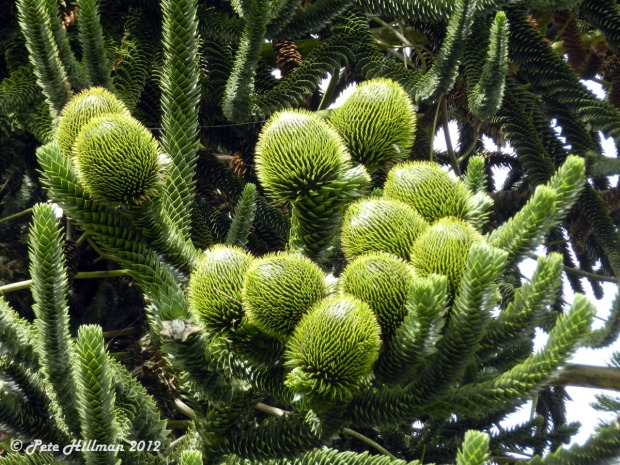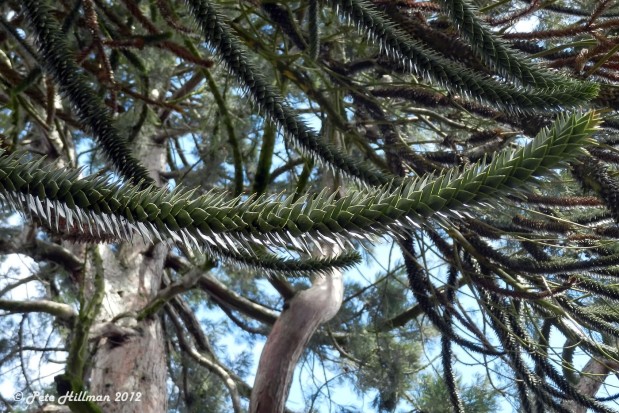Araucaria araucana
This tree was around some 200 million years ago when dinosaurs roamed the planet, and its sharp-pointed needles aided it in keeping browsing animals at bay. It is sometimes refered to as a ‘living fossil’.
Also called the ‘Chile Pine’, or ‘Chilean Pine’, this is a magnificent and exotic, evergreen ornamental tree which was widely planted in Victorian and Edwardian parks and gardens. The trees are either male or female, and generally have a single tall, straight trunk, an evolutionary trait to help keep the leaves away from browsing dinosaurs. It can grow up to 30m (98ft) in height. The leaves are scale-like, triangular and rigid, and dark green in colour. The globular female cones are 15cms across, and ripen in the second year, breaking up on the tree. The nuts produced are similar to Brazil nuts.
Widely grown as an ornamental in parks and gardens. They can live up p to 1,000 years in its native countries, up to 150 years in Britain. Originally a native of Chile and Argentina, it is fairly common and widespread throughout Britain.
The Monkey Puzzle tree was discovered by a Spanish explorer called Don Francisco Dendariarena in the 1780s. It is believed to have been introduced to Britain by the Scottish plant-hunter Archibald Menzies in 1792. He is supposed to have slipped five of the nuts into his pocket after been given them as a dessert during a banquet at Valparaiso, and then managed to germinate them on the voyage back home. Grown as exotic ornamentals in gardens, it was said that the many intricate formed branches of the tree were enough to puzzle a climbing monkey.
June 2012, local park, Staffordshire. © Pete Hillman 2012.




Amazing plant – thanks for the history, too.
LikeLiked by 1 person
Thank you, Eliza 🙂
LikeLike
I always wanted one in the garden!
LikeLiked by 1 person
Me, too, lol! But they can grow pretty big.
LikeLiked by 1 person
Very interesting info/photo of the Chilean Pine – I’ve never seen one. We have some nice Monkey Trees here as well … I recently photographed a large one with snow-covered branches which I may post sometime.
LikeLiked by 1 person
Thank you, Michael 🙂 They do look quite beautiful covered in snow. It would be nice to see your tree posted.
LikeLiked by 1 person
Interesting introduction to this tree. Wonderful detail in the first photo.
LikeLiked by 1 person
Thank you 🙂 Those are the female cones in the first image.
LikeLiked by 1 person
That is a funny but right name for the tree 😀
LikeLiked by 1 person
🙂
LikeLike
Very interesting and quite beautiful. Have never seen this type of tree before. 🙂
LikeLiked by 1 person
Thank you, Peggy. It is quite an unusual one, especially when you walk past one growing in somebodys front garden.
LikeLiked by 1 person
Hi Pete … this monkey puzzle tree brings back memories. They were quite common in the Lower Mainland of BC when I was growing up. Thanks for the back story — quite a history. 🙂
LikeLiked by 1 person
Thank you, Sally 🙂 I have always found these trees very interesting.
LikeLiked by 1 person
I would love to see one in reality – it’s wonderful!
LikeLiked by 1 person
Thank you, Marilyn 🙂 It is quite a sight to see 🙂
LikeLike
Thanks for the post and history of this odd tree. Here in Portland, Oregon on the west coast it is not uncommon to find mature specimens in the city. Seedlings were given away at Portland’s 1905 Lewis & Clark Exposition leading to many trees of the same size in the older close-in residential neighborhoods that were just developing at that time.
LikeLiked by 1 person
I am glad you enjoyed the post 🙂 It is interesting how this tree has made its way around the globe. Thank you for your comment 🙂
LikeLike